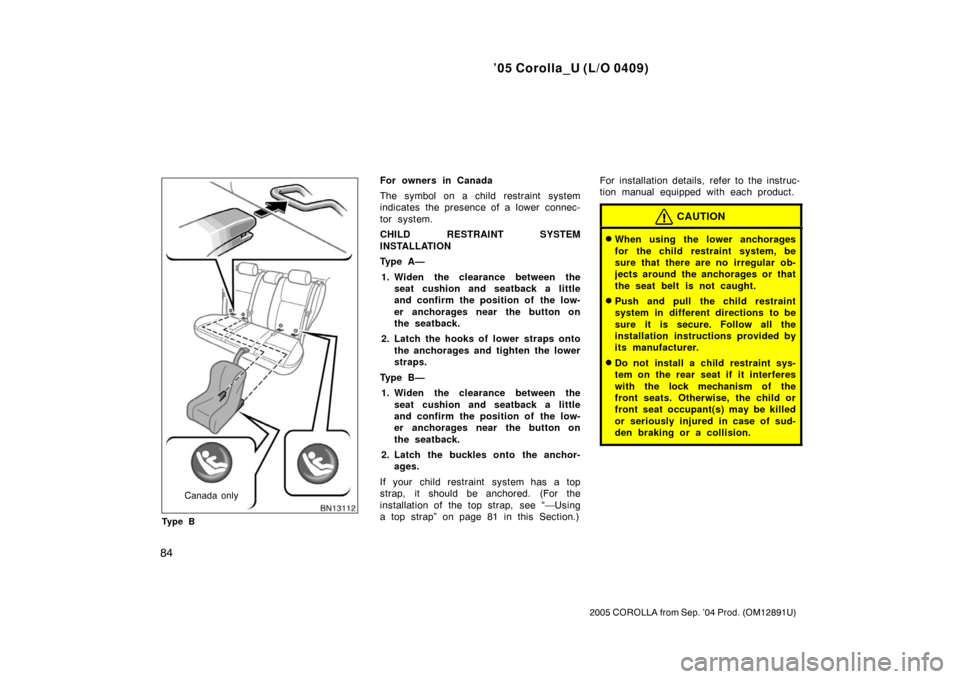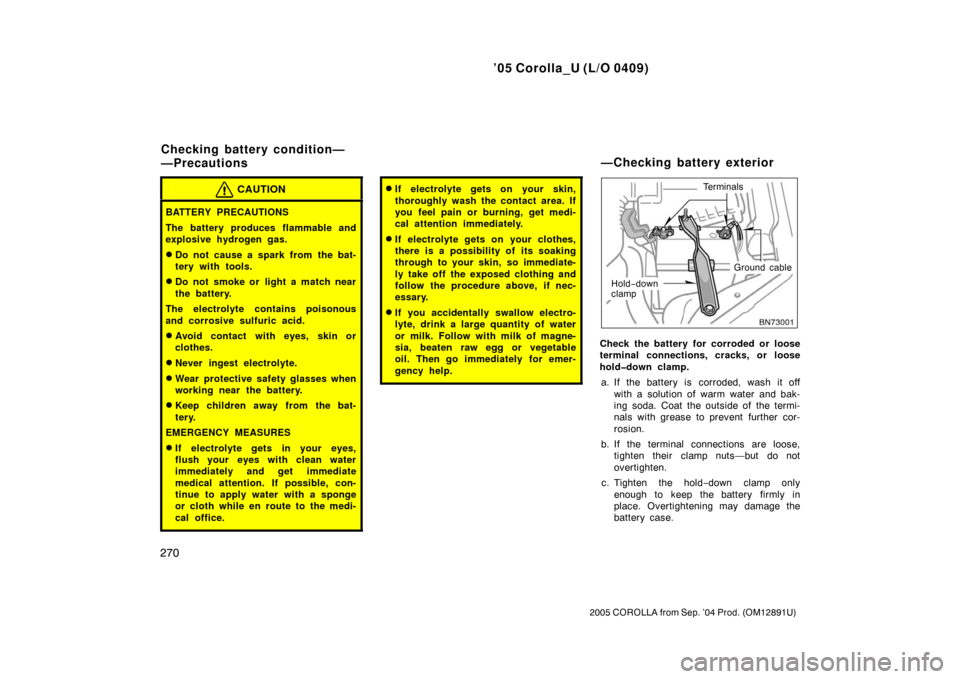Page 91 of 304
’05 Corolla_U (L/O 0409)
81
2005 COROLLA from Sep. ’04 Prod. (OM12891U)
2. To remove the child restraint system,press the buckle release button and
allow the belt to retract.Follow the procedure below for a child
restraint system that requires the use
of a top strap.
Anchor brackets Symbol
Use the anchor brackets on the luggage
compartment to attach the top strap.
Anchor brackets are installed for each
rear seating position.
This symbol indicates the location of the
anchor bracket.
— U sin g a to p st rap
Page 92 of 304
’05 Corolla_U (L/O 0409)
82
2005 COROLLA from Sep. ’04 Prod. (OM12891U)
TO USE THE ANCHOR BRACKET:1. Remove the head restraint.2. Open the lid of the anchor bracket.3. Securely fasten the child restraint system with the seat belt.
Latch the hook onto the anchor
bracket and tighten the top strap.
For instructions to install the child re-
straint system, see “Child restraint” on
page 68 in this Section.
CAUTION
Make sure the top strap is securely
latched, and check that the child re-
straint system is secure by pushing
and pulling it in different directions.
Follow all the installation instructions
provided by its manufacturer.
Page 93 of 304
’05 Corolla_U (L/O 0409)
83
2005 COROLLA from Sep. ’04 Prod. (OM12891U)
4. Replace the head restraint.Lower anchorages for the child restraint
systems complying with the FMVSS225
or CMVSS210.2 specifications are
installed in the rear seat.
The anchorages are installed in the clear-
ance between the seat cushion and seat-
back of both outside rear seats.
Child restraint systems complying with the
FMVSS225 or CMVSS210.2 specification
can be fixed to these anchorages. In this
case, it is not necessary to fix the child
restraint system with a seat belt on the
vehicle.
Canada only
Ty p e A
—Installation with child
restraint lower anchorages
Page 94 of 304

’05 Corolla_U (L/O 0409)
84
2005 COROLLA from Sep. ’04 Prod. (OM12891U)
Canada only
Ty p e B
For owners in Canada
The symbol on a child restraint system
indicates the presence of a lower connec-
tor system.
CHILD RESTRAINT SYSTEM
INSTALLATION
Ty p e A — 1. Widen the clearance between the seat cushion and seatback a little
and confirm the position of the low-
er anchorages near the button on
the seatback.
2. Latch the hooks of lower straps onto the anchorages and tighten the lower
straps.
Ty p e B — 1. Widen the clearance between the seat cushion and seatback a little
and confirm the position of the low-
er anchorages near the button on
the seatback.
2. Latch the buckles onto the anchor- ages.
If your child restraint system has a top
strap, it should be anchored. (For the
installation of the top strap, see “—Using
a top strap” on page 81 in this Section.) For installation details, refer to the instruc-
tion manual equipped with each product.
CAUTION
�When using the lower anchorages
for the child restraint system, be
sure that there are no irregular ob-
jects around the anchorages or that
the seat belt is not caught.
�Push and pull the child restraint
system in different directions to be
sure it is secure. Follow all the
installation instructions provided by
its manufacturer.
�Do not install a child restraint sys-
tem on the rear seat if it interferes
with the lock mechanism of the
front seats. Otherwise, the child or
front seat occupant(s) may be killed
or seriously injured in case of sud-
den braking or a collision.
Page 261 of 304

’05 Corolla_U (L/O 0409)
251
2005 COROLLA from Sep. ’04 Prod. (OM12891U)
CAUTION
�When the engine is running, keep
hands, clothing, and tools away
from the moving fan and engine
drive belts. (Removing rings,
watches, and ties is advisable.)
�Right after driving, the engine
compartment—the engine, radiator,
exhaust manifold and spark plug
boots, etc.—will be hot. So be care-
ful not to touch them. Oil, fluids
and spark plugs may also be hot.
�If the engine is hot, do not remove
the radiator cap or loosen the drain
plugs to prevent burning yourself.
�Do not leave anything that may
burn easily, such as paper or rags,
in the engine compartment.
�Do not smoke, cause sparks or al-
low open flames around fuel or the
battery. Their fumes are flammable.
�Do not get under your vehicle with
just the body jack supporting it. Al-
ways use automotive jack stands or
other solid supports.
�Be sure that the ignition is off if
you work near the electric cooling
fans or radiator grille. With the
ignition on, the electric cooling fans
will automatically start to run if the
engine coolant temperature is high
and/or the air conditioning is on.
�Use eye protection whenever you
work on or under your vehicle
where you may be exposed to flying
or falling material, fluid spray, etc.
�Used engine oil contains potentially
harmful contaminants which may
cause skin disorders such as in-
flammation or skin cancer, so care
should be taken to avoid prolonged
and repeated contact with it. To re-
move used engine oil from your
skin, wash thoroughly with soap
and water.
�Do not leave used oil within the
reach of children.
�Dispose of used oil and filter only
in a safe and acceptable manner.
Do not dispose of used oil and fil-
ter in household trash, in sewers or
onto the ground. Call your dealer or
a service station for information
concerning recycling or disposal.
�Be extremely cautious when work-
ing on the battery. It contains poi-
sonous and corrosive sulfuric acid.
NOTICE
�Remember that battery and ignition
cables carry high currents or volt-
ages. Be careful of accidentally
causing a short circuit.
� Add only “Toyota Super Long Life
Coolant” or similar high quality eth-
ylene glycol based non�silicate,
non�amine, non�nitrite, and non�bo-
rate coolant with long�life hybrid
organic acid technology to fill the
radiator. “Toyota Super Long Life
Coolant” is a mixture of 50% cool-
ant and 50% deionized water (for
the U.S.A.) or 55% coolant and 45%
deionized water (for Canada).
� If you spill some of the coolant, be
sure to wash it off with water to
prevent it from damaging the parts
or paint.
� Do not allow dirt or anything else
to fall through the spark plugholes.
Page 280 of 304

’05 Corolla_U (L/O 0409)
270
2005 COROLLA from Sep. ’04 Prod. (OM12891U)
CAUTION
BATTERY PRECAUTIONS
The battery produces flammable and
explosive hydrogen gas.
�Do not cause a spark from the bat-
tery with tools.
�Do not smoke or light a match near
the battery.
The electrolyte contains poisonous
and corrosive sulfuric acid.
�Avoid contact with eyes, skin or
clothes.
�Never ingest electrolyte.
�Wear protective safety glasses when
working near the battery.
�Keep children away from the bat-
tery.
EMERGENCY MEASURES
�If electrolyte gets in your eyes,
flush your eyes with clean water
immediately and get immediate
medical attention. If possible, con-
tinue to apply water with a sponge
or cloth while en route to the medi-
cal office.
�If electrolyte gets on your skin,
thoroughly wash the contact area. If
you feel pain or burning, get medi-
cal attention immediately.
�If electrolyte gets on your clothes,
there is a possibility of its soaking
through to your skin, so immediate-
ly take off the exposed clothing and
follow the procedure above, if nec-
essary.
�If you accidentally swallow electro-
lyte, drink a large quantity of water
or milk. Follow with milk of magne-
sia, beaten raw egg or vegetable
oil. Then go immediately for emer-
gency help.
Terminals
Hold −down
clamp Ground cable
Check the battery for corroded or loose
terminal connections, cracks, or loose
hold�down clamp.
a. If the battery is corroded, wash it off with a solution of warm water and bak-
ing soda. Coat the outside of the termi-
nals with grease to prevent further cor-
rosion.
b. If the terminal connections are loose, tighten their clamp nuts—but do not
overtighten.
c. Tighten the hold −down clamp only
enough to keep the battery firmly in
place. Overtightening may damage the
battery case.
Checking battery c ondition—
—Precautions —Checking battery exterior